Impact of Government Reforms on Australia's Agriculture Industry
VerifiedAdded on 2020/03/16
|9
|1444
|50
Report
AI Summary
This report provides a comprehensive analysis of the reforms implemented in the Australian agricultural industry. It examines the government's interest in the sector, highlighting policies aimed at improving productivity and supporting farmers. The report discusses the impact of technological advancements, such as the Internet of Things (IoT), on farming practices. It analyzes the contribution of the agricultural sector to Australia's GDP and employment, supported by figures from ABS.gov. The report also provides recommendations for policyholders, emphasizing the importance of rural counseling programs and addressing farmers' needs. It concludes by underscoring the potential of the agricultural sector to drive economic growth, emphasizing the need for continued reforms and investments. The report references various academic sources to support its findings.

Running head: REFORMS IN AGRICULTURE INDUSTRY IN AUSTRALIA
REFORMS IN AGRICULTURE INDUSTRY IN AUSTRALIA
Name of the Student
Name of the University
Author’s Note
REFORMS IN AGRICULTURE INDUSTRY IN AUSTRALIA
Name of the Student
Name of the University
Author’s Note
Paraphrase This Document
Need a fresh take? Get an instant paraphrase of this document with our AI Paraphraser
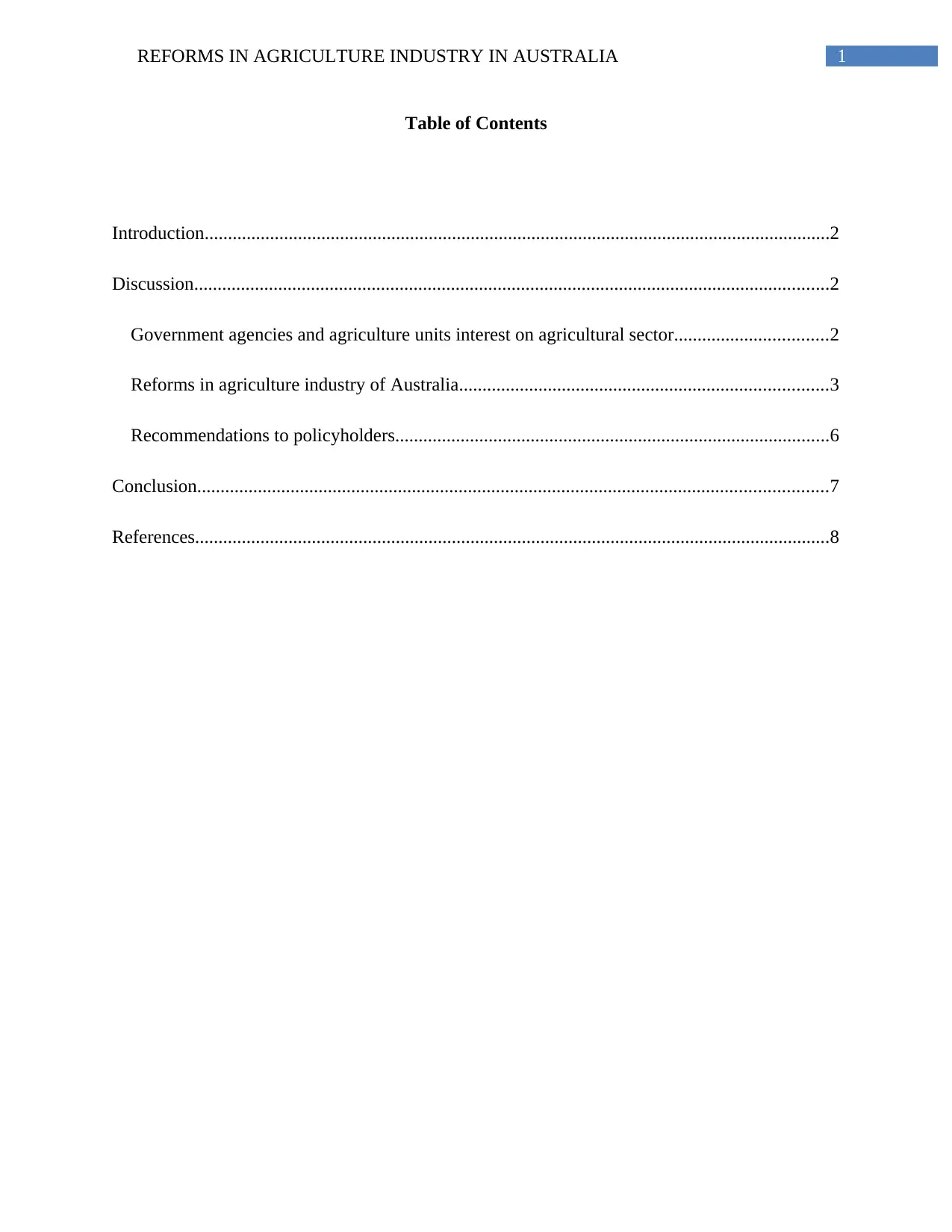
1REFORMS IN AGRICULTURE INDUSTRY IN AUSTRALIA
Table of Contents
Introduction......................................................................................................................................2
Discussion........................................................................................................................................2
Government agencies and agriculture units interest on agricultural sector.................................2
Reforms in agriculture industry of Australia...............................................................................3
Recommendations to policyholders.............................................................................................6
Conclusion.......................................................................................................................................7
References........................................................................................................................................8
Table of Contents
Introduction......................................................................................................................................2
Discussion........................................................................................................................................2
Government agencies and agriculture units interest on agricultural sector.................................2
Reforms in agriculture industry of Australia...............................................................................3
Recommendations to policyholders.............................................................................................6
Conclusion.......................................................................................................................................7
References........................................................................................................................................8
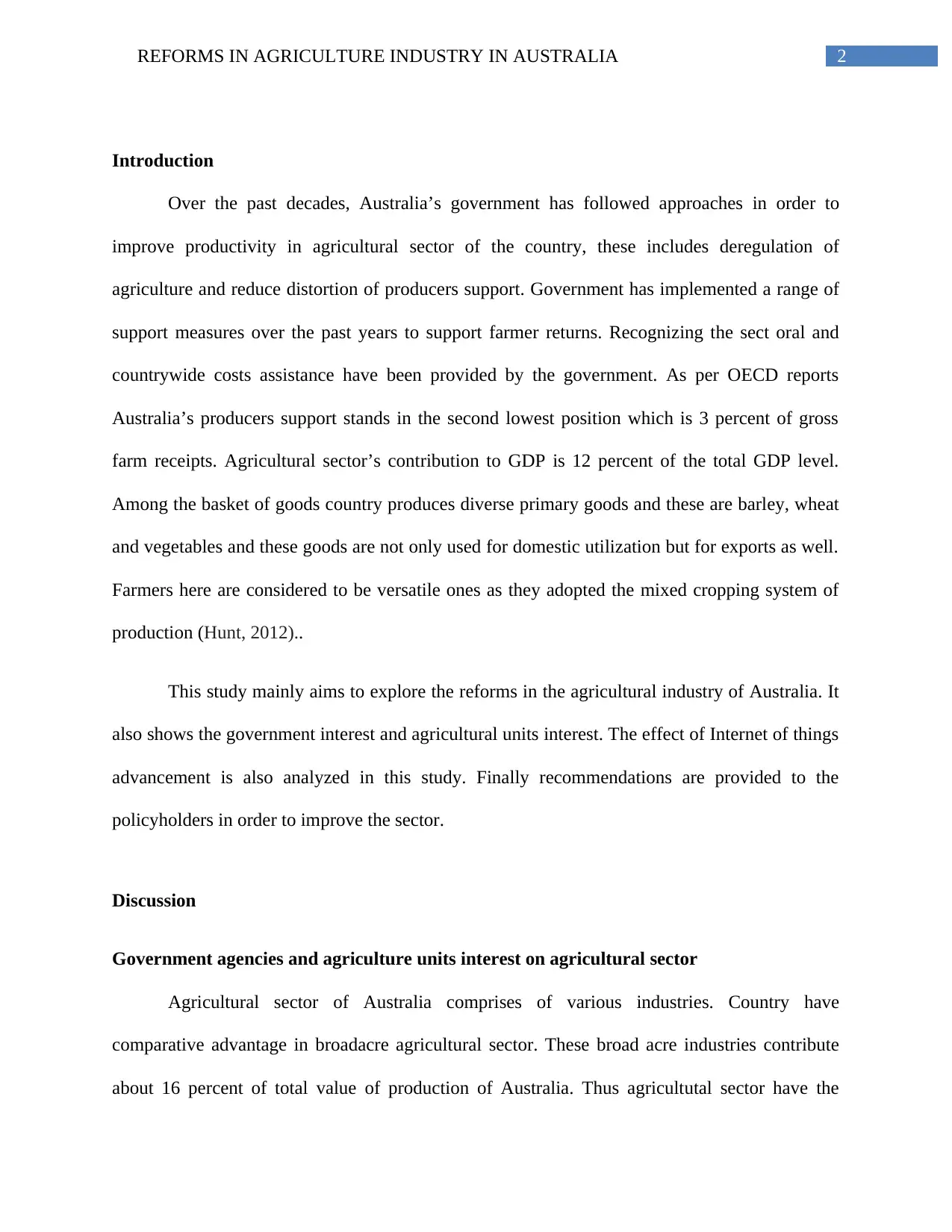
2REFORMS IN AGRICULTURE INDUSTRY IN AUSTRALIA
Introduction
Over the past decades, Australia’s government has followed approaches in order to
improve productivity in agricultural sector of the country, these includes deregulation of
agriculture and reduce distortion of producers support. Government has implemented a range of
support measures over the past years to support farmer returns. Recognizing the sect oral and
countrywide costs assistance have been provided by the government. As per OECD reports
Australia’s producers support stands in the second lowest position which is 3 percent of gross
farm receipts. Agricultural sector’s contribution to GDP is 12 percent of the total GDP level.
Among the basket of goods country produces diverse primary goods and these are barley, wheat
and vegetables and these goods are not only used for domestic utilization but for exports as well.
Farmers here are considered to be versatile ones as they adopted the mixed cropping system of
production (Hunt, 2012)..
This study mainly aims to explore the reforms in the agricultural industry of Australia. It
also shows the government interest and agricultural units interest. The effect of Internet of things
advancement is also analyzed in this study. Finally recommendations are provided to the
policyholders in order to improve the sector.
Discussion
Government agencies and agriculture units interest on agricultural sector
Agricultural sector of Australia comprises of various industries. Country have
comparative advantage in broadacre agricultural sector. These broad acre industries contribute
about 16 percent of total value of production of Australia. Thus agricultutal sector have the
Introduction
Over the past decades, Australia’s government has followed approaches in order to
improve productivity in agricultural sector of the country, these includes deregulation of
agriculture and reduce distortion of producers support. Government has implemented a range of
support measures over the past years to support farmer returns. Recognizing the sect oral and
countrywide costs assistance have been provided by the government. As per OECD reports
Australia’s producers support stands in the second lowest position which is 3 percent of gross
farm receipts. Agricultural sector’s contribution to GDP is 12 percent of the total GDP level.
Among the basket of goods country produces diverse primary goods and these are barley, wheat
and vegetables and these goods are not only used for domestic utilization but for exports as well.
Farmers here are considered to be versatile ones as they adopted the mixed cropping system of
production (Hunt, 2012)..
This study mainly aims to explore the reforms in the agricultural industry of Australia. It
also shows the government interest and agricultural units interest. The effect of Internet of things
advancement is also analyzed in this study. Finally recommendations are provided to the
policyholders in order to improve the sector.
Discussion
Government agencies and agriculture units interest on agricultural sector
Agricultural sector of Australia comprises of various industries. Country have
comparative advantage in broadacre agricultural sector. These broad acre industries contribute
about 16 percent of total value of production of Australia. Thus agricultutal sector have the
⊘ This is a preview!⊘
Do you want full access?
Subscribe today to unlock all pages.

Trusted by 1+ million students worldwide
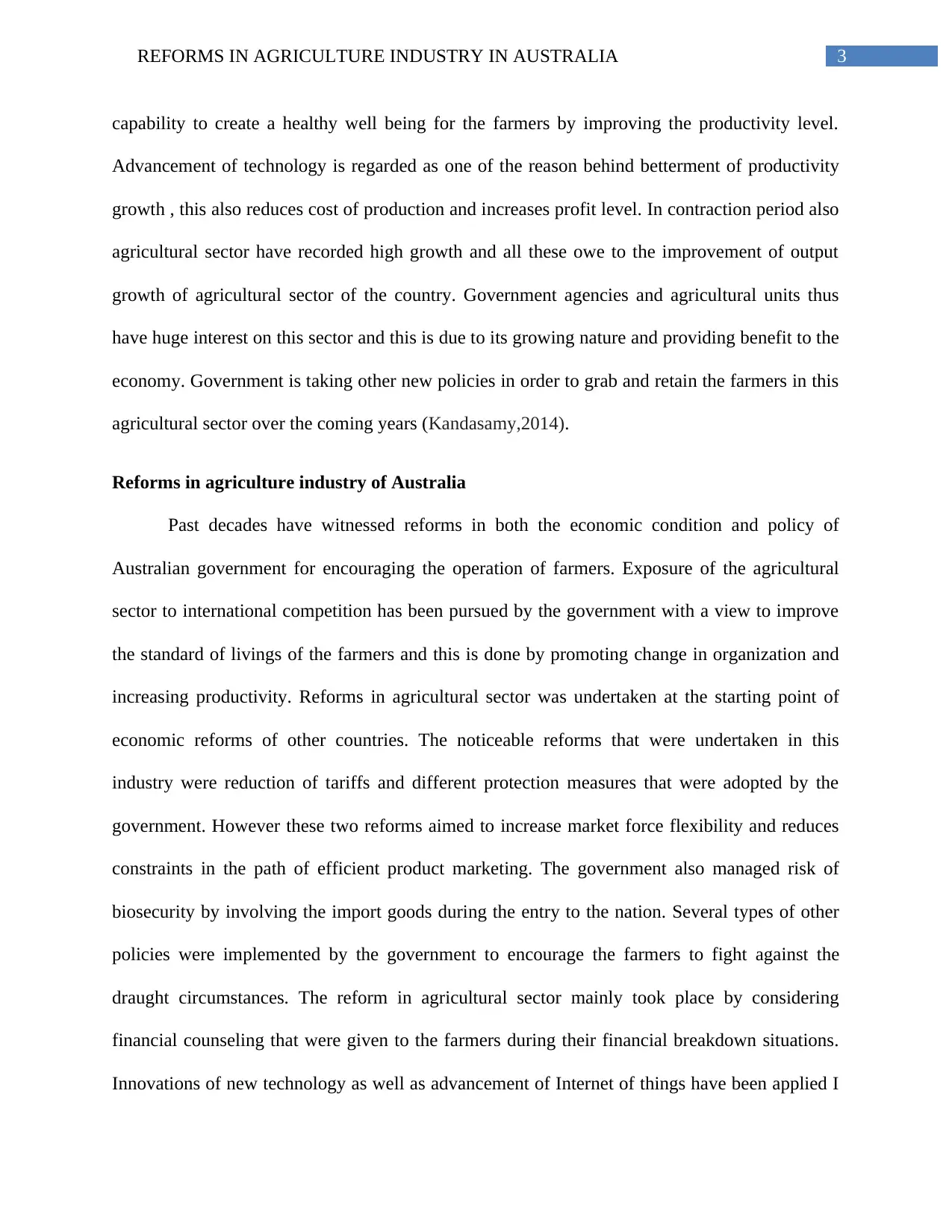
3REFORMS IN AGRICULTURE INDUSTRY IN AUSTRALIA
capability to create a healthy well being for the farmers by improving the productivity level.
Advancement of technology is regarded as one of the reason behind betterment of productivity
growth , this also reduces cost of production and increases profit level. In contraction period also
agricultural sector have recorded high growth and all these owe to the improvement of output
growth of agricultural sector of the country. Government agencies and agricultural units thus
have huge interest on this sector and this is due to its growing nature and providing benefit to the
economy. Government is taking other new policies in order to grab and retain the farmers in this
agricultural sector over the coming years (Kandasamy,2014).
Reforms in agriculture industry of Australia
Past decades have witnessed reforms in both the economic condition and policy of
Australian government for encouraging the operation of farmers. Exposure of the agricultural
sector to international competition has been pursued by the government with a view to improve
the standard of livings of the farmers and this is done by promoting change in organization and
increasing productivity. Reforms in agricultural sector was undertaken at the starting point of
economic reforms of other countries. The noticeable reforms that were undertaken in this
industry were reduction of tariffs and different protection measures that were adopted by the
government. However these two reforms aimed to increase market force flexibility and reduces
constraints in the path of efficient product marketing. The government also managed risk of
biosecurity by involving the import goods during the entry to the nation. Several types of other
policies were implemented by the government to encourage the farmers to fight against the
draught circumstances. The reform in agricultural sector mainly took place by considering
financial counseling that were given to the farmers during their financial breakdown situations.
Innovations of new technology as well as advancement of Internet of things have been applied I
capability to create a healthy well being for the farmers by improving the productivity level.
Advancement of technology is regarded as one of the reason behind betterment of productivity
growth , this also reduces cost of production and increases profit level. In contraction period also
agricultural sector have recorded high growth and all these owe to the improvement of output
growth of agricultural sector of the country. Government agencies and agricultural units thus
have huge interest on this sector and this is due to its growing nature and providing benefit to the
economy. Government is taking other new policies in order to grab and retain the farmers in this
agricultural sector over the coming years (Kandasamy,2014).
Reforms in agriculture industry of Australia
Past decades have witnessed reforms in both the economic condition and policy of
Australian government for encouraging the operation of farmers. Exposure of the agricultural
sector to international competition has been pursued by the government with a view to improve
the standard of livings of the farmers and this is done by promoting change in organization and
increasing productivity. Reforms in agricultural sector was undertaken at the starting point of
economic reforms of other countries. The noticeable reforms that were undertaken in this
industry were reduction of tariffs and different protection measures that were adopted by the
government. However these two reforms aimed to increase market force flexibility and reduces
constraints in the path of efficient product marketing. The government also managed risk of
biosecurity by involving the import goods during the entry to the nation. Several types of other
policies were implemented by the government to encourage the farmers to fight against the
draught circumstances. The reform in agricultural sector mainly took place by considering
financial counseling that were given to the farmers during their financial breakdown situations.
Innovations of new technology as well as advancement of Internet of things have been applied I
Paraphrase This Document
Need a fresh take? Get an instant paraphrase of this document with our AI Paraphraser
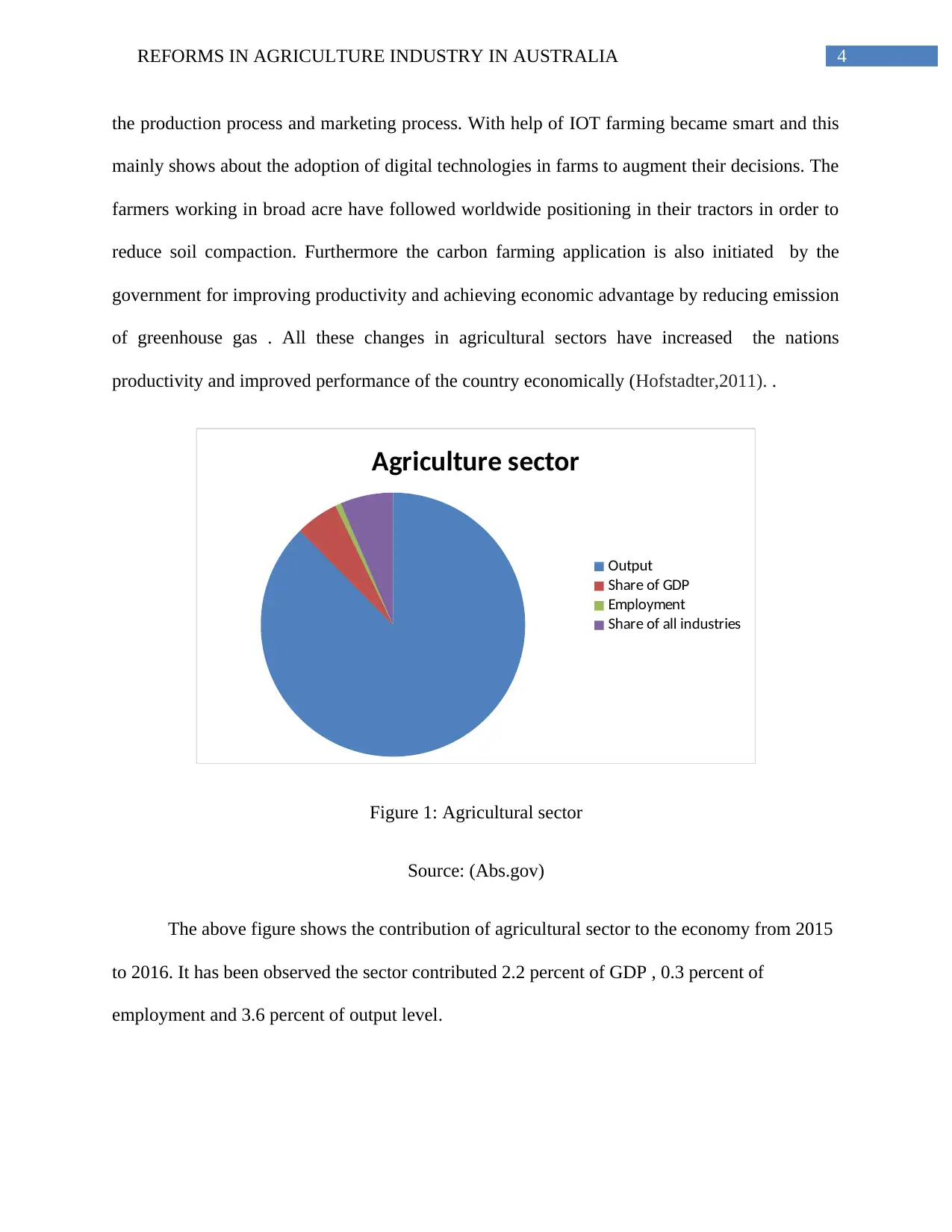
4REFORMS IN AGRICULTURE INDUSTRY IN AUSTRALIA
the production process and marketing process. With help of IOT farming became smart and this
mainly shows about the adoption of digital technologies in farms to augment their decisions. The
farmers working in broad acre have followed worldwide positioning in their tractors in order to
reduce soil compaction. Furthermore the carbon farming application is also initiated by the
government for improving productivity and achieving economic advantage by reducing emission
of greenhouse gas . All these changes in agricultural sectors have increased the nations
productivity and improved performance of the country economically (Hofstadter,2011). .
Agriculture sector
Output
Share of GDP
Employment
Share of all industries
Figure 1: Agricultural sector
Source: (Abs.gov)
The above figure shows the contribution of agricultural sector to the economy from 2015
to 2016. It has been observed the sector contributed 2.2 percent of GDP , 0.3 percent of
employment and 3.6 percent of output level.
the production process and marketing process. With help of IOT farming became smart and this
mainly shows about the adoption of digital technologies in farms to augment their decisions. The
farmers working in broad acre have followed worldwide positioning in their tractors in order to
reduce soil compaction. Furthermore the carbon farming application is also initiated by the
government for improving productivity and achieving economic advantage by reducing emission
of greenhouse gas . All these changes in agricultural sectors have increased the nations
productivity and improved performance of the country economically (Hofstadter,2011). .
Agriculture sector
Output
Share of GDP
Employment
Share of all industries
Figure 1: Agricultural sector
Source: (Abs.gov)
The above figure shows the contribution of agricultural sector to the economy from 2015
to 2016. It has been observed the sector contributed 2.2 percent of GDP , 0.3 percent of
employment and 3.6 percent of output level.
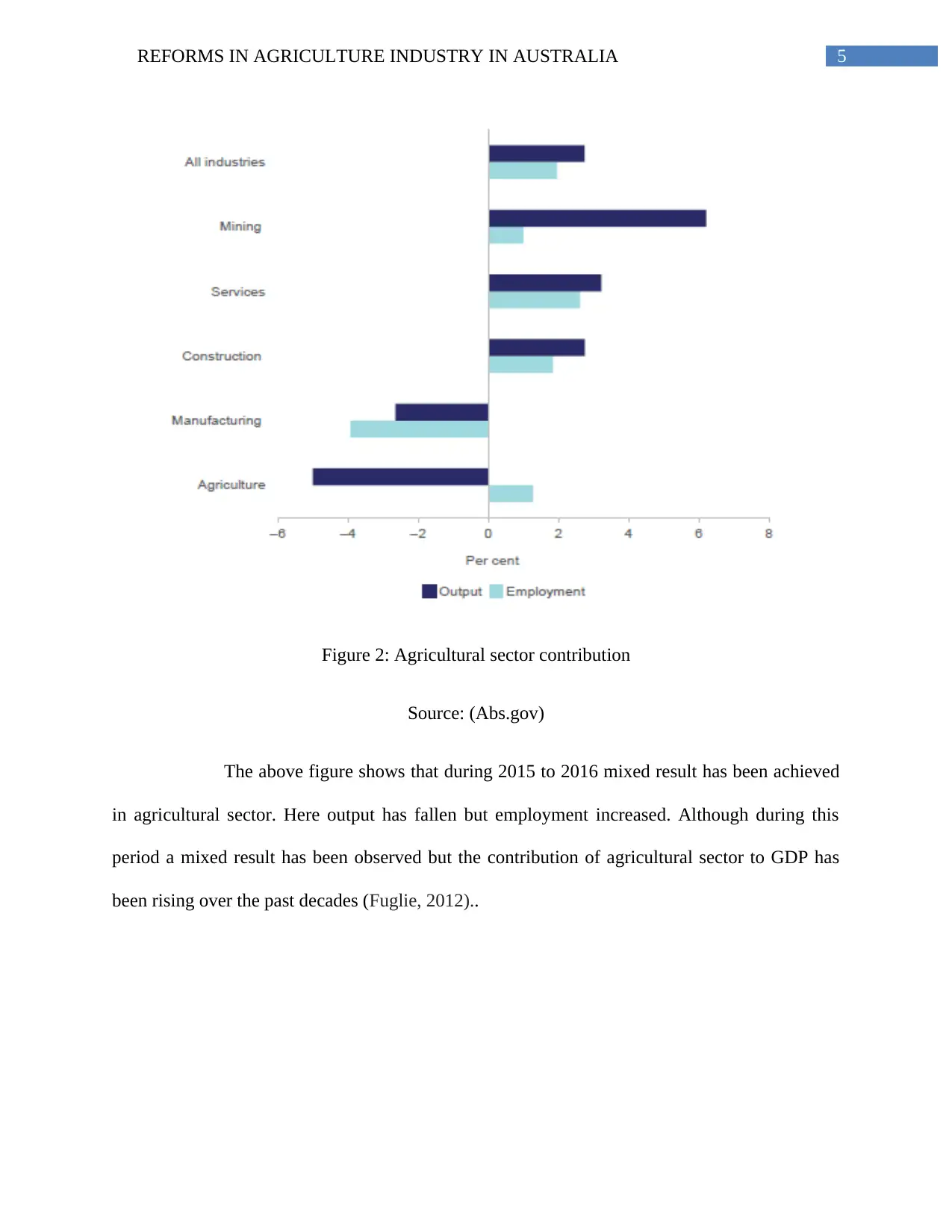
5REFORMS IN AGRICULTURE INDUSTRY IN AUSTRALIA
Figure 2: Agricultural sector contribution
Source: (Abs.gov)
The above figure shows that during 2015 to 2016 mixed result has been achieved
in agricultural sector. Here output has fallen but employment increased. Although during this
period a mixed result has been observed but the contribution of agricultural sector to GDP has
been rising over the past decades (Fuglie, 2012)..
Figure 2: Agricultural sector contribution
Source: (Abs.gov)
The above figure shows that during 2015 to 2016 mixed result has been achieved
in agricultural sector. Here output has fallen but employment increased. Although during this
period a mixed result has been observed but the contribution of agricultural sector to GDP has
been rising over the past decades (Fuglie, 2012)..
⊘ This is a preview!⊘
Do you want full access?
Subscribe today to unlock all pages.

Trusted by 1+ million students worldwide
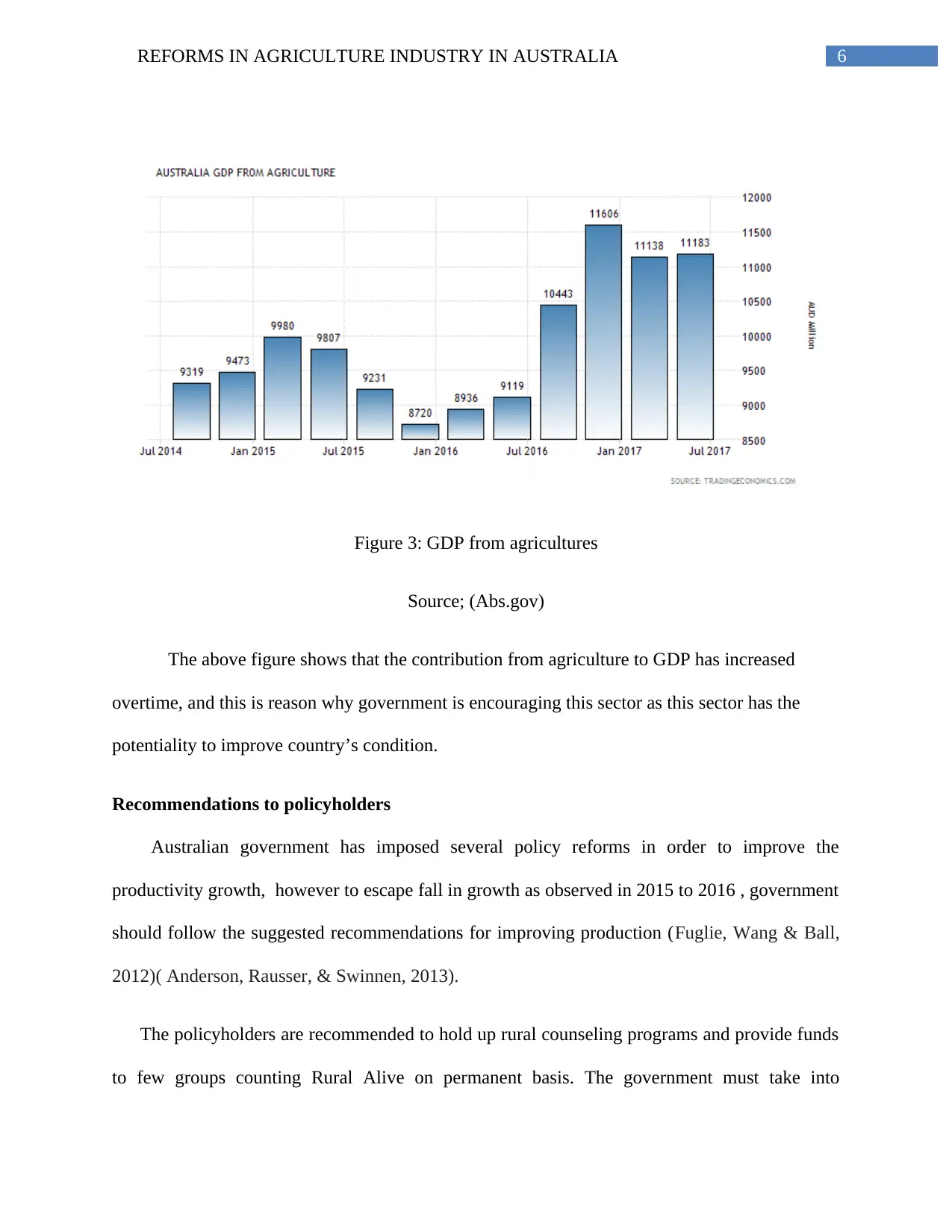
6REFORMS IN AGRICULTURE INDUSTRY IN AUSTRALIA
Figure 3: GDP from agricultures
Source; (Abs.gov)
The above figure shows that the contribution from agriculture to GDP has increased
overtime, and this is reason why government is encouraging this sector as this sector has the
potentiality to improve country’s condition.
Recommendations to policyholders
Australian government has imposed several policy reforms in order to improve the
productivity growth, however to escape fall in growth as observed in 2015 to 2016 , government
should follow the suggested recommendations for improving production (Fuglie, Wang & Ball,
2012)( Anderson, Rausser, & Swinnen, 2013).
The policyholders are recommended to hold up rural counseling programs and provide funds
to few groups counting Rural Alive on permanent basis. The government must take into
Figure 3: GDP from agricultures
Source; (Abs.gov)
The above figure shows that the contribution from agriculture to GDP has increased
overtime, and this is reason why government is encouraging this sector as this sector has the
potentiality to improve country’s condition.
Recommendations to policyholders
Australian government has imposed several policy reforms in order to improve the
productivity growth, however to escape fall in growth as observed in 2015 to 2016 , government
should follow the suggested recommendations for improving production (Fuglie, Wang & Ball,
2012)( Anderson, Rausser, & Swinnen, 2013).
The policyholders are recommended to hold up rural counseling programs and provide funds
to few groups counting Rural Alive on permanent basis. The government must take into
Paraphrase This Document
Need a fresh take? Get an instant paraphrase of this document with our AI Paraphraser
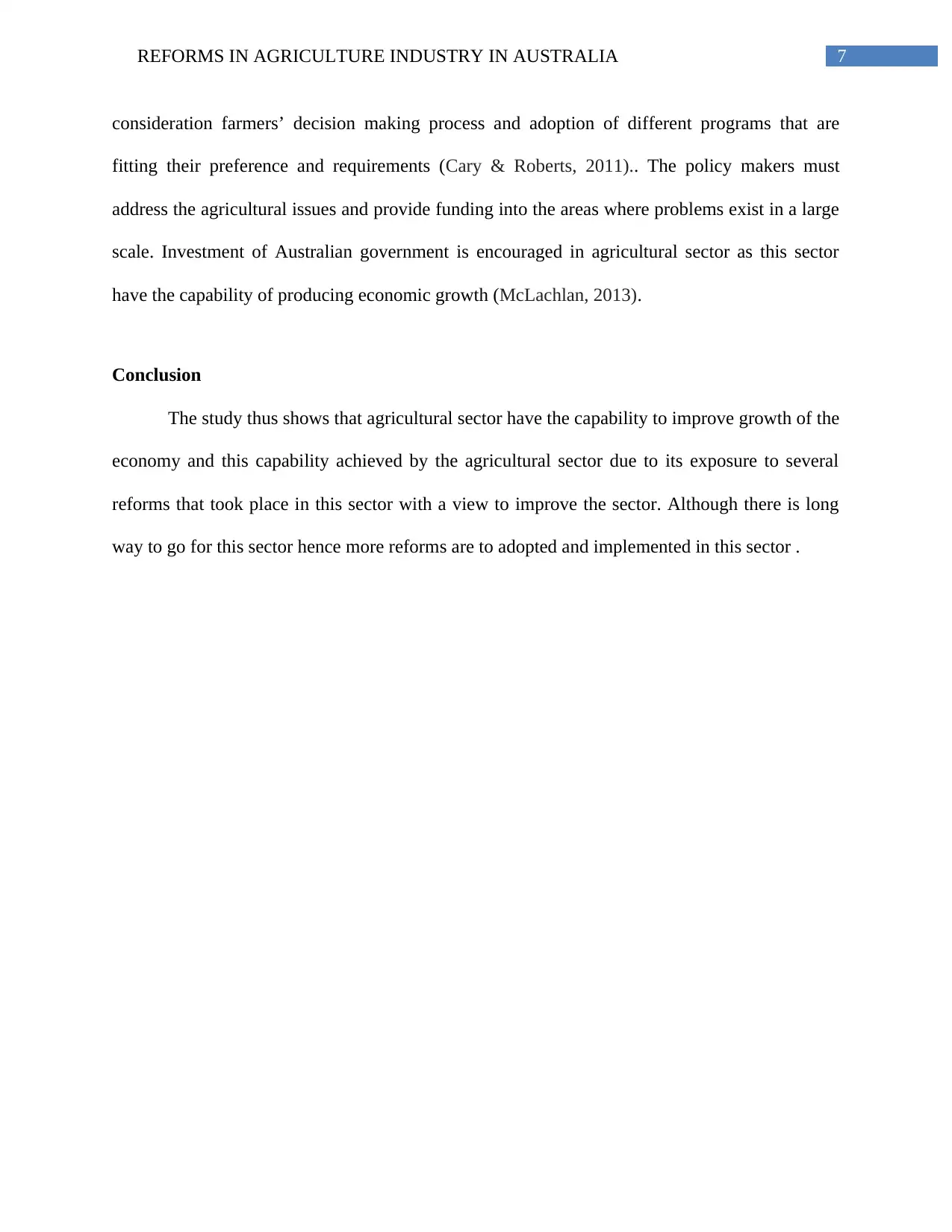
7REFORMS IN AGRICULTURE INDUSTRY IN AUSTRALIA
consideration farmers’ decision making process and adoption of different programs that are
fitting their preference and requirements (Cary & Roberts, 2011).. The policy makers must
address the agricultural issues and provide funding into the areas where problems exist in a large
scale. Investment of Australian government is encouraged in agricultural sector as this sector
have the capability of producing economic growth (McLachlan, 2013).
Conclusion
The study thus shows that agricultural sector have the capability to improve growth of the
economy and this capability achieved by the agricultural sector due to its exposure to several
reforms that took place in this sector with a view to improve the sector. Although there is long
way to go for this sector hence more reforms are to adopted and implemented in this sector .
consideration farmers’ decision making process and adoption of different programs that are
fitting their preference and requirements (Cary & Roberts, 2011).. The policy makers must
address the agricultural issues and provide funding into the areas where problems exist in a large
scale. Investment of Australian government is encouraged in agricultural sector as this sector
have the capability of producing economic growth (McLachlan, 2013).
Conclusion
The study thus shows that agricultural sector have the capability to improve growth of the
economy and this capability achieved by the agricultural sector due to its exposure to several
reforms that took place in this sector with a view to improve the sector. Although there is long
way to go for this sector hence more reforms are to adopted and implemented in this sector .
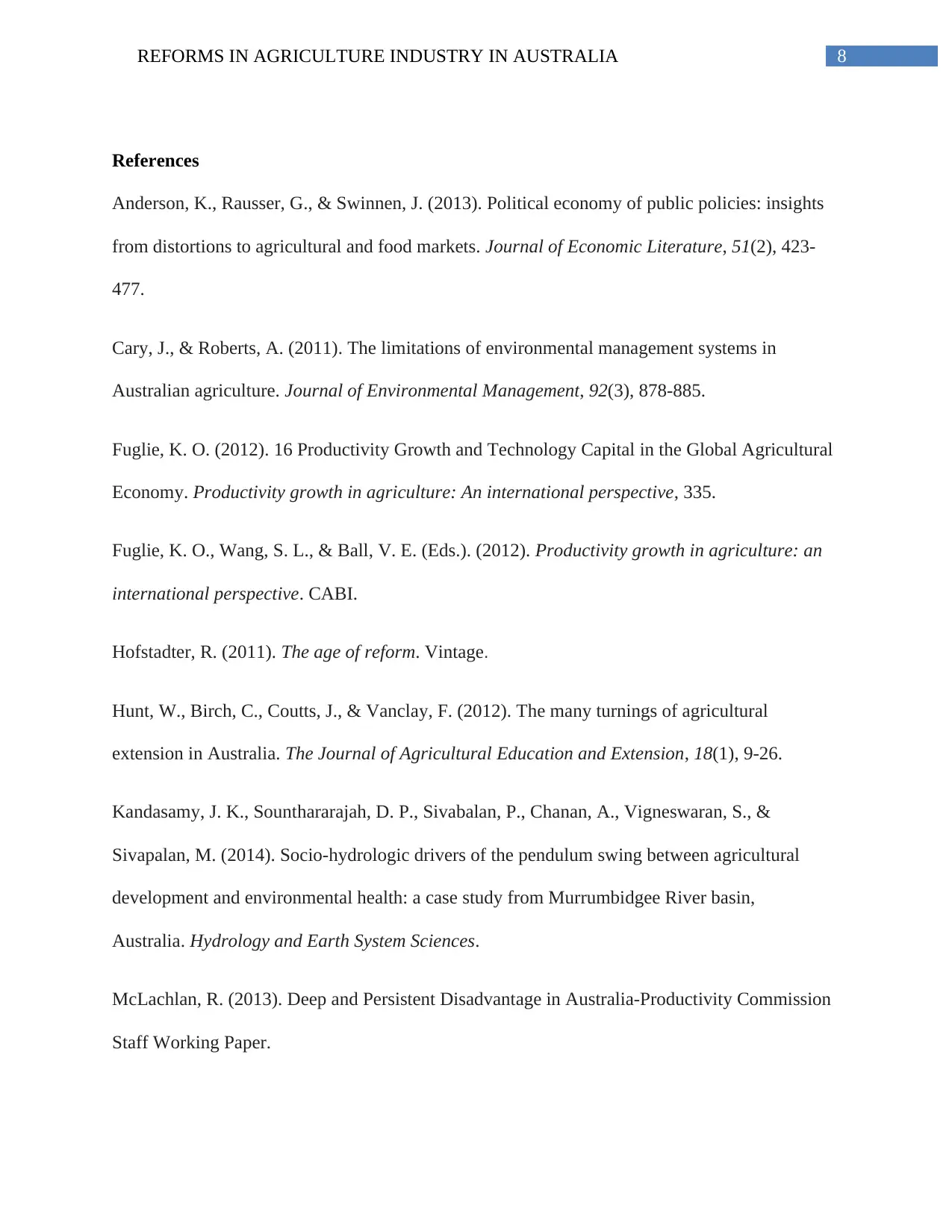
8REFORMS IN AGRICULTURE INDUSTRY IN AUSTRALIA
References
Anderson, K., Rausser, G., & Swinnen, J. (2013). Political economy of public policies: insights
from distortions to agricultural and food markets. Journal of Economic Literature, 51(2), 423-
477.
Cary, J., & Roberts, A. (2011). The limitations of environmental management systems in
Australian agriculture. Journal of Environmental Management, 92(3), 878-885.
Fuglie, K. O. (2012). 16 Productivity Growth and Technology Capital in the Global Agricultural
Economy. Productivity growth in agriculture: An international perspective, 335.
Fuglie, K. O., Wang, S. L., & Ball, V. E. (Eds.). (2012). Productivity growth in agriculture: an
international perspective. CABI.
Hofstadter, R. (2011). The age of reform. Vintage.
Hunt, W., Birch, C., Coutts, J., & Vanclay, F. (2012). The many turnings of agricultural
extension in Australia. The Journal of Agricultural Education and Extension, 18(1), 9-26.
Kandasamy, J. K., Sounthararajah, D. P., Sivabalan, P., Chanan, A., Vigneswaran, S., &
Sivapalan, M. (2014). Socio-hydrologic drivers of the pendulum swing between agricultural
development and environmental health: a case study from Murrumbidgee River basin,
Australia. Hydrology and Earth System Sciences.
McLachlan, R. (2013). Deep and Persistent Disadvantage in Australia-Productivity Commission
Staff Working Paper.
References
Anderson, K., Rausser, G., & Swinnen, J. (2013). Political economy of public policies: insights
from distortions to agricultural and food markets. Journal of Economic Literature, 51(2), 423-
477.
Cary, J., & Roberts, A. (2011). The limitations of environmental management systems in
Australian agriculture. Journal of Environmental Management, 92(3), 878-885.
Fuglie, K. O. (2012). 16 Productivity Growth and Technology Capital in the Global Agricultural
Economy. Productivity growth in agriculture: An international perspective, 335.
Fuglie, K. O., Wang, S. L., & Ball, V. E. (Eds.). (2012). Productivity growth in agriculture: an
international perspective. CABI.
Hofstadter, R. (2011). The age of reform. Vintage.
Hunt, W., Birch, C., Coutts, J., & Vanclay, F. (2012). The many turnings of agricultural
extension in Australia. The Journal of Agricultural Education and Extension, 18(1), 9-26.
Kandasamy, J. K., Sounthararajah, D. P., Sivabalan, P., Chanan, A., Vigneswaran, S., &
Sivapalan, M. (2014). Socio-hydrologic drivers of the pendulum swing between agricultural
development and environmental health: a case study from Murrumbidgee River basin,
Australia. Hydrology and Earth System Sciences.
McLachlan, R. (2013). Deep and Persistent Disadvantage in Australia-Productivity Commission
Staff Working Paper.
⊘ This is a preview!⊘
Do you want full access?
Subscribe today to unlock all pages.

Trusted by 1+ million students worldwide
1 out of 9
Related Documents
Your All-in-One AI-Powered Toolkit for Academic Success.
+13062052269
info@desklib.com
Available 24*7 on WhatsApp / Email
![[object Object]](/_next/static/media/star-bottom.7253800d.svg)
Unlock your academic potential
Copyright © 2020–2025 A2Z Services. All Rights Reserved. Developed and managed by ZUCOL.





